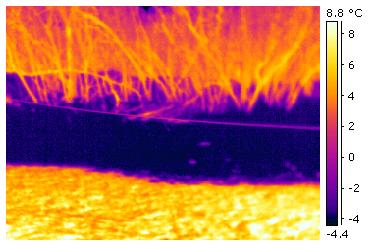User:Hotflashhome
I have been a thermographer from 2004 until present and have been interested in the limits to which this science can be taken. To this end he has published articles in 2007 and 2008 to aid in quantification of power losses in systems from Infrared Radiation.
To better help everyone to understand this science I would like to point out how Infrared Radiation works in the real world. Heat losses from homes and buildings have little to do with air temperature since most buildings lose 60 to 80 percent of heat from radiation. Our radiation environment is vastly different from the world we see.
Two Thermal Images have been created to help us with this Radiation Environment. Both these thermographs were taken on the same day. Remember that the air temperature when these thermographs were taken was at 0 degrees Celsius.
The first series illustrates the radiating environment of a sunny wall. The aluminium pie plate is used to capture the radiating environment that this wall is radiating at.
The temperature of the radiating environment is almost -6 Degrees Celsius. This is far colder than the air temperature. This radiating temperature powers the heat losses in this thermograph! What is the radiating environment?
This thermograph shows the trees, snow and sky which powers the heat losses ot the wall.
The North Wall is shaded but its radiating environment is much different.
This wall is radiating at an environment which is much colder. The radiating temperature in the thermograph is almost -16 Degrees Celsius. Remember the air temperature is at about freezing.
This wall is radiating at a much colder horizon. In fact, the camera is only capable of recording radiation to -45 Degrees Celcuis. The predominent radiant absorber is the sky, but the wall is also radiating at the water, far shore and the hills in the background. All these temperatures are shown in the thermogaph's scale.
Our radiating environment is much different than what we see. However that environment powers heat losses to this wall and to our bodies. We feel the heat from a warm fire on our faces and we feel the cold when our faces radiate at a colder environment.




